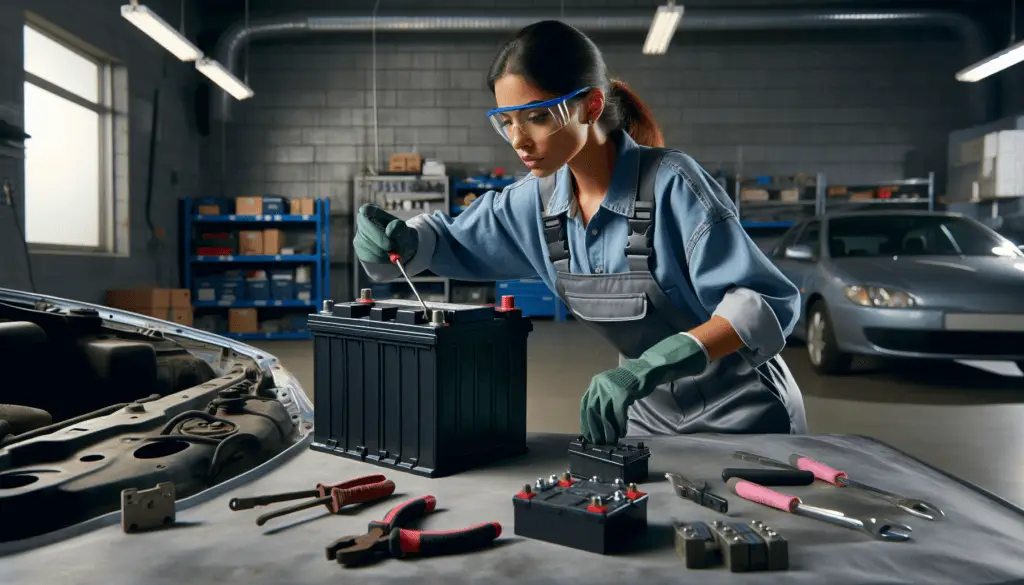The Ultimate Guide To Car Battery Replacement
In this comprehensive guide, you will discover everything you need to know about car battery replacement. Whether you’re a seasoned driver or a first-time car owner, understanding the process of replacing your car battery is essential for keeping your vehicle running smoothly. From choosing the right battery for your car to step-by-step instructions on how to safely replace it, this guide has got you covered. So, let’s get started and ensure that you’re well-equipped to handle any battery-related issues that may come your way.

Preparing for Car Battery Replacement
Before replacing your car battery, there are a few important steps to take in order to ensure a smooth and successful replacement process. First, it’s crucial to determine the age of your battery. Knowing how old your battery is can give you an idea of its expected lifespan and whether or not it’s time for a replacement. Most car batteries are designed to last around 3-5 years, so if your battery is approaching or exceeding this timeframe, it’s likely time for a replacement.
In addition to checking the battery’s age, it’s important to understand the signs of a failing battery. Some common signs include difficulty starting the car, dimming headlights, and a battery warning light on the dashboard. If you’re experiencing any of these symptoms, it’s a good indication that your battery is failing and needs to be replaced.
Once you’ve determined that a battery replacement is necessary, it’s time to gather the necessary tools and materials. Some common tools and materials you’ll need include gloves, safety goggles, a wrench, a battery cleaning solution, a wire brush, and of course, a new replacement battery. Having these items on hand before starting the replacement process will help ensure a smooth and efficient installation.
Choosing the Right Car Battery
Choosing the right car battery is crucial for optimal performance and longevity. To determine the correct battery type for your vehicle, consult your car’s owner’s manual or check the specifications on your existing battery. There are various battery types available, including lead-acid, AGM, and lithium-ion, each with their own advantages and considerations.
In addition to battery type, it’s important to consider the battery’s capacity and reserve capacity. The capacity refers to the amount of energy the battery can store, while the reserve capacity is the amount of time the battery can provide power to the vehicle in the event of a charging system failure. Choosing a battery with sufficient capacity and reserve capacity is essential for reliable performance.
Checking the dimensions and terminal placement of the battery is also important. Car batteries come in different sizes, so it’s crucial to choose one that fits properly in the battery tray of your vehicle. Additionally, ensure that the positive and negative terminals of the new battery align with the corresponding terminals in your vehicle.
Lastly, it’s worth considering the battery brand and warranty. Opting for a reputable brand and a battery with a solid warranty can provide peace of mind and ensure that you’re getting a quality product that will last.
Removing the Old Car Battery
Before installing a new battery, it’s necessary to remove the old one. To begin, locate the battery in the engine compartment. In most vehicles, the battery is easily accessible and can be found near the front of the engine bay.
Start by removing the battery’s negative terminal. Use a wrench to loosen the nut on the negative terminal, then gently pry it off the battery post. Be careful not to touch any metal surfaces or other terminals while doing this, as it can result in a short circuit.
Next, remove the battery’s positive terminal in the same manner as the negative terminal. Again, use a wrench to loosen the nut, pry off the terminal, and keep it away from any metal surfaces.
If your battery has a clamp or hold-down securing it in place, remove it next. Depending on the design, you may need to use a wrench or socket to loosen and remove the hold-down. Once the clamp or hold-down is removed, the battery should be free to be taken out of the engine compartment.
Cleaning the Battery Area
Before installing the new battery, it’s important to clean the battery area to ensure optimal performance and longevity. Start by cleaning corrosion from the battery terminals and cables. Corrosion can hinder the battery’s ability to properly conduct electricity, so it’s important to remove any build-up.
Using a battery cleaning solution and a wire brush, gently scrub the terminals and cables to remove any corrosion. Take care to not let any of the solution or debris come into contact with your skin or eyes, as it can cause irritation. After scrubbing, rinse the terminals and cables with clean water to remove any remaining solution.
While cleaning the terminals and cables, take the opportunity to inspect the battery tray for rust or damage. If any rust or damage is present, it’s important to address it before installing the new battery. Rust can weaken the tray and potentially lead to future problems, so consider using a rust converter or replacing the tray if necessary.
Once the battery tray is inspected and cleaned, clean the surrounding area to remove any dirt or debris. This will help ensure a clean and secure installation of the new battery.
Installing the New Car Battery
With the old battery removed and the area cleaned, it’s time to install the new car battery. Start by placing the new battery into the engine compartment, ensuring it is properly aligned with the battery tray.
Once the battery is in place, secure it with the hold-down or clamp that was removed earlier. Use a wrench or socket to tighten the hold-down, ensuring the battery is securely in place and cannot move.
Next, connect the positive terminal to the battery. Place the terminal over the battery post and use a wrench to tighten the nut, ensuring a secure connection. Take care not to overtighten, as this can damage the terminal or battery post.
Similarly, attach the negative terminal to the battery. Place the terminal over the battery post and tighten the nut with a wrench. Again, avoid overtightening.
After both terminals are securely connected, ensure that all connections are tight by giving them a gentle tug. Loose connections can result in poor performance or even electrical issues, so it’s important to ensure a secure fit.
Testing the New Car Battery
Once the new car battery is installed, it’s important to test its functionality to ensure optimal performance. Start by cleaning the battery terminals to remove any residue or dirt that may have accumulated during the installation process.
After cleaning, perform a battery voltage test using a multimeter. This will help determine if the battery is providing the correct voltage output. Consult your vehicle’s owner’s manual for the recommended voltage range.
Alternatively, you can use a battery load tester to assess the battery’s overall health and capacity. This test applies a load to the battery to measure its performance under real-world conditions. Follow the manufacturer’s instructions for proper usage of the load tester.
Additionally, it’s important to check for proper charging voltage. Use a voltmeter to measure the voltage at the battery terminals while the vehicle is running. The voltage should be within the recommended range as specified in the owner’s manual.
Maintaining the Car Battery
To ensure the longevity and optimal performance of your car battery, regular maintenance is essential. Regularly inspect the battery for signs of damage or corrosion. If corrosion is present on the terminals or cables, clean it using a battery cleaning solution and a wire brush.
Avoid deep discharge of the battery, as this can cause permanent damage. If your vehicle will be sitting for an extended period of time, consider using a battery maintainer or disconnecting the battery to prevent discharge.
Keeping the battery charged is also important for maintaining its performance. If your vehicle has infrequent usage or short trips, consider investing in a battery charger to keep the battery at the recommended charge level.
Recycling and Disposing of Old Car Batteries
Proper disposal and recycling of old car batteries is essential for environmental and safety reasons. Car batteries contain hazardous materials, such as lead and sulfuric acid, which can be harmful if not disposed of correctly.
It’s important to understand the importance of recycling and to dispose of old car batteries responsibly. Many authorized recycling centers or auto dealerships accept old batteries for recycling. These facilities have the proper equipment and processes in place to safely handle and recycle the batteries.
Before recycling the old battery, it’s important to properly prepare it. This includes cleaning any corrosion or debris from the terminals and cables, securing them to prevent any accidental contact, and placing the battery in a secure container to prevent leaks or spills during transportation.
Common Mistakes to Avoid
When replacing your car battery, it’s important to avoid common mistakes that can lead to issues down the road. One common mistake is rushing the battery replacement process. Take your time to ensure each step is done correctly and safely.
Another mistake to avoid is connecting the terminals incorrectly. Mixing up the positive and negative terminals can result in electrical problems or even damage to the battery or electrical system. Always double-check the proper terminal connections before tightening.
Using the wrong battery type or size is also a common mistake. Each vehicle requires a specific battery type and size, so be sure to consult your owner’s manual or check the specifications on the existing battery before purchasing a replacement.
Neglecting to clean the battery area before installing the new battery is another mistake to avoid. Corrosion and debris can interfere with the battery’s performance and lead to premature failure. Take the time to properly clean the terminals, cables, and surrounding area.
Lastly, disposing of the old battery improperly is a mistake to avoid. Improper disposal can harm the environment and potentially result in fines or penalties. Always recycle old car batteries at authorized facilities to ensure they are handled safely and responsibly.
Frequently Asked Questions (FAQs)
How often should a car battery be replaced?
The lifespan of a car battery can vary depending on usage, climate, and other factors. On average, car batteries last around 3-5 years. However, it’s important to monitor the signs of a failing battery and replace it when necessary.
Can I replace the car battery myself?
Yes, replacing a car battery is a relatively simple process that can be done by most vehicle owners. However, it’s important to follow proper safety precautions and guidelines to ensure a successful and safe battery replacement.
Why is it important to use the correct battery type?
Using the correct battery type is important because each vehicle has specific requirements for optimal performance. Using the wrong battery type can lead to issues such as poor starting, inadequate power supply, and potential damage to the electrical system.
Can a dead car battery be recharged?
In some cases, a dead car battery can be recharged. This typically requires the use of a battery charger to slowly recharge the battery. However, it’s important to note that if a battery consistently dies or loses charge, it may be a sign of a larger issue and should be replaced.
